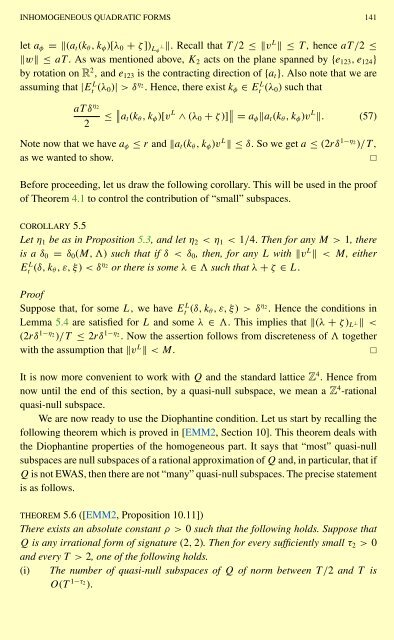NEAR OPTIMAL BOUNDS IN FREIMAN'S THEOREM
NEAR OPTIMAL BOUNDS IN FREIMAN'S THEOREM
NEAR OPTIMAL BOUNDS IN FREIMAN'S THEOREM
You also want an ePaper? Increase the reach of your titles
YUMPU automatically turns print PDFs into web optimized ePapers that Google loves.
<strong>IN</strong>HOMOGENEOUS QUADRATIC FORMS 141<br />
let aφ =(at(kθ,kφ)[λ0 + ζ ]) Lφ ⊥. Recall that T/2 ≤vL ≤T, hence aT/2 ≤<br />
w ≤aT. As was mentioned above, K2 acts on the plane spanned by {e123,e124}<br />
by rotation on R 2 , and e123 is the contracting direction of {at}. Also note that we are<br />
assuming that |E L t (λ0)| >δ η2 . Hence, there exist kφ ∈ E L t (λ0) such that<br />
aT δ η2<br />
2 ≤ at(kθ,kφ)[v L ∧ (λ0 + ζ )] = aφat(kθ,kφ)v L . (57)<br />
Note now that we have aφ ≤ r and at(kθ,kφ)v L ≤δ. So we get a ≤ (2rδ 1−η2 )/T,<br />
as we wanted to show. <br />
Before proceeding, let us draw the following corollary. This will be used in the proof<br />
of Theorem 4.1 to control the contribution of “small” subspaces.<br />
COROLLARY 5.5<br />
Let η1 be as in Proposition 5.3, and let η2 1, there<br />
is a δ0 = δ0(M,) such that if δ2, one of the following holds.<br />
(i) The number of quasi-null subspaces of Q of norm between T/2 and T is<br />
O(T 1−τ2 ).

















